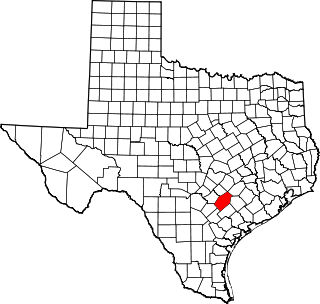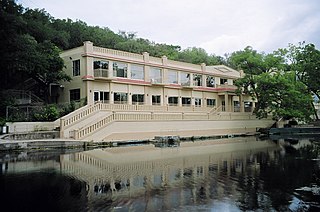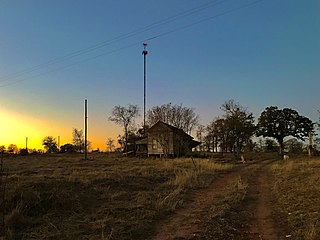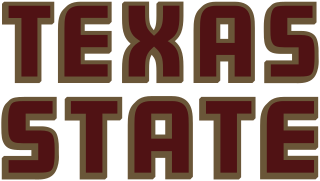Related Research Articles

Hays County is located on the Edwards Plateau in the U.S. state of Texas. Hays County is part of the Austin-Round Rock metropolitan area. As of the 2010 census, its official population had reached 157,107. The county seat is San Marcos. Hays, along with Comal and Kendall Counties, was listed in 2017 as one of the nation's fastest-growing large counties with a population of at least 10,000. From 2015 to 2016, Hays County, third on the national list, had nearly 10,000 new residents during the year. Comal County, sixth on the list, grew by 5,675 newcomers, or 4.4%. Kendall County, the second-fastest growing county in the nation, grew by 5.16%. As a result of this growth, the counties have experienced new home construction, traffic congestion, and greater demand for public services. Bexar County, which includes San Antonio, grew by 1.75% during the year, but its sheer number of new residents exceeded 33,000.

Gonzales County is a county in the U.S. state of Texas, adjacent to Greater Austin-San Antonio. As of the 2010 census, its population was 19,807. The county is named for its county seat, the city of Gonzales. The county was created in 1836 and organized the following year. As of August 2020, under strict budgetary limitations, the County of Gonzales government-body is unique in that it claims to have no commercial paper, regarding it as "the absence of any county debt."

San Marcos is a city and the county seat of Hays County, Texas, United States. The city's limits extend into Caldwell and Guadalupe counties, as well. San Marcos is within the Austin–Round Rock–San Marcos metropolitan area and on the Interstate 35 corridor between Austin and San Antonio. Its population was 44,894 at the 2010 census and 67,553 at the 2020 census. Founded on the banks of the San Marcos River, the area is thought to be among the oldest continuously inhabited sites in the Americas. San Marcos is home to Texas State University and the Meadows Center for Water and the Environment.

The Texas Hill Country is a geographic region of Central and South Texas, forming the southeast part of the Edwards Plateau. Given its location, climate, terrain, and vegetation, the Hill Country can be considered the border between the American Southeast and Southwest. The region represents the very remote rural countryside of Central Texas but also is home to growing suburban neighborhoods and affluent retirement communities.

The Balcones Fault or Balcones Fault Zone is an area of largely normal faulting in the U.S. state of Texas that runs roughly from the southwest part of the state near Del Rio to the north-central region near Dallas along Interstate 35. The Balcones Fault zone is made up of many smaller features, including normal faults, grabens, and horsts. One of the obvious features is the Mount Bonnell Fault.

Narceus americanus is a large millipede of eastern North America. Common names include American giant millipede, worm millipede, and iron worm. It inhabits the eastern seaboard of North America west to Georgetown, Texas, north of the Ottine wetlands. It has a nearly cylindrical gray body, reaching a length of 4 inches (100 mm). When threatened, they sometimes curl up or release a noxious liquid that contains large amounts of benzoquinones which can cause dermatological burns. This fluid may irritate eyes or skin. Many other millipedes secrete hydrogen cyanide, and while there have also been claims that N. americanus releases hydrogen cyanide, this is not true. They do however, excrete a substance that causes a temporary, non-harmful discoloration of the skin.
San Marcos is the Spanish name of Saint Mark. It may also refer to:

The Meadows Center for Water and the Environment, formerly Aquarena Springs and later the Aquarena Center, is an educational center in San Marcos, Texas, that seeks to preserve the unique archeological and biological resources of Spring Lake. Formed from more than 200 artesian springs, this lake is one of the world's largest aquifer fed system. A state antiquities landmark, this site is also believed to be one of the longest continuously inhabited places in North America.

The San Marcos River rises from the San Marcos Springs, the location of Aquarena Springs, in San Marcos, Texas. The springs are home to several threatened or endangered species, including the Texas blind salamander, fountain darter, and Texas wild rice. The river is a popular recreational area, and is frequented for tubing, canoeing, swimming, and fishing.

The Rainwater Basin wetland region is a 4,200 sq mi (11,000 km2) loess plain located south of the Platte River in south-central Nebraska. It lies principally in Adams, Butler, Clay, Fillmore, Hamilton, Kearney, Phelps, Polk, Saline, Seward, and York counties and extends into adjacent areas of southeastern Hall, northern Franklin, northern Nuckolls, western Saline, northern Thayer and northwestern Webster counties. Before European settlement, this plain was covered by prairie grasslands interspersed with thousands of ephemeral playa wetlands, called Rainwater Basins. Informally and locally, individual Nebraska Rainwater Basins are referred to as rainbasins, basins, lagoons, lakes, ponds, marshes, hay marshes, and lakes marshes. To the west, a tallgrass prairie in the east once gradually transitioned into mixed grass prairie. Currently, the Rainwater Basin wetland region is covered by farms, mainly growing corn and soybeans. Several, interspersed, stream courses, of which largest is the Big Blue River and its tributaries, drain this region. Riparian woodlands and upland slopes possessing oak woodlands are associated with these streams. In the spring and fall months, millions of migratory birds pass through the region to feed and rest. Along with riparian habitats associated Platte River, Big Blue River, its tributaries, and smaller streams, Rainwater Basins are a major component of the Central Flyway of North America.

The culture of Texas is often considered one of the major cultures influencing the greater American culture. Texas is both one of the most populous and populated American states in its urban centers, and has seen tremendous waves of migration out of the American North and West in contrast to its eastern neighbors in the Deep South. But it retains the regionalisms and distinct cultural identities of Tejanos, Cajuns, Irish, African American, and Anglo American enclaves established prior to the republic era and admission to statehood.

German Texan is both a term to describe immigrants who arrived in the Republic of Texas from Germany from the 1830s onward and an ethnic category that includes their descendants in today's state of Texas. The arriving Germans tended to cluster in ethnic enclaves; the majority settled in a broad, fragmented belt across the south-central part of the state, where many became farmers. As of 1990, about three million Texans considered themselves at least part German in ancestry, a subgroup of German Americans.

Austin–Round Rock–San Marcos is a five-county metropolitan area in the U.S. state of Texas, as defined by the Office of Management and Budget. The metropolitan area is situated in Central Texas on the eastern edge of the American Southwest, and borders Greater San Antonio to the south.

Texas State University is a public research university in San Marcos, Texas. Established in 1899 as the Southwest Texas State Normal School, it opened in 1903 to 303 students. Since that time it has grown into the largest institution in the Texas State University System and the fifth-largest university in the state of Texas. In 2013, Associated Student Government senator Quentin De La Garza successfully pushed legislation to change the name from Texas State University-San Marcos to Texas State University. With an enrollment of over 38,500 students for the 2018 fall semester. It has ten colleges and about fifty schools and departments.

Central Texas is a region in the U.S. state of Texas surrounding Austin and roughly bordered by San Saba to Bryan and San Marcos to Hillsboro. Central Texas overlaps with and includes part of the Texas Hill Country and corresponds to a physiographic section designation within the Edwards Plateau, in a geographic context.

Belmont, officially known as the "Belmont Site," is an unincorporated area of approximately 40 square miles in extreme western Gonzales County adjacent to Greater Austin, north of the "Belmont intersection" at the “Leesville Quad” water-testing site, electorally known as local Precinct 5. The population of Belmont-proper has been rated at 36 employees, with the greater area rated at 1,169 residents. The area is defined by the limits of the northern and western county line, bordered by the significant 1800s land grants of Eliza Dewitt, Ira Nash, Samuel Robbins and Thomas Decrew. It is served by the Belmont Volunteer Fire Department.

The ironcolor shiner is a species of freshwater ray-finned fish from the family Cyprinidae, the minnows and carps. It is a widespread species in streams and rivers in eastern North America.
Occupy Texas State is a student activist group formed at Texas State University - San Marcos. It is distinguished from the off-campus but allied Occupy San Marcos.
Orontium mackii is an extinct golden club species in the family Araceae described from a series of isolated fossil leaves. The species is known from Late Cretaceous sediments exposed in the state of New Mexico in the United States of America. It is one of several extinct species placed in the living golden-club genus Orontium.

The I-35 Rivalry is a college rivalry between the Texas State University Bobcats and the University of Texas at San Antonio Roadrunners. It is named for the Interstate Highway that connects the two universities.
References
- ↑ Taber, Stephen Welton; Fleenor, Scott B. (2005). Invertebrates of Central Texas Wetlands. Texas Tech University Press. p. 3-26. ISBN 978-0-89672-550-8.
- ↑ Raun, G. G. (1959). "Terrestrial and aquatic vertebrates of a moist, relict area in central Texas". Texas Journal of Science. 11: 158–171.
- ↑ Swanson, Romey Lynn (2009). Temporal and Spatial Trends of the Amphibians, Reptiles, and Mammals of the Relict Ottine Wetlands (M.S.). Texas State University-San Marcos.
